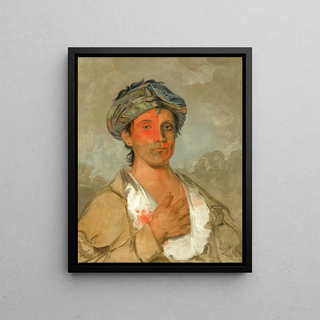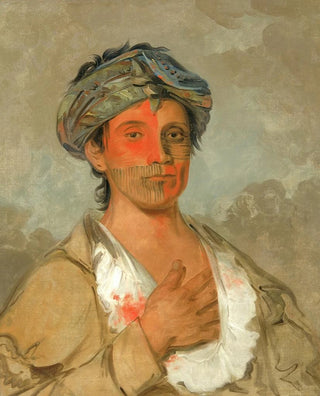Art print | Pahtecosaw Homme hétéro semi-civilisé - George Catlin


View from behind

Frame (optional)
"Pahtecosaw Hetero Semi-Civilized Man" - George Catlin – Captivating Introduction
In the vast panorama of American art history, the artwork "Pahtecosaw Hetero Semi-Civilized Man" by George Catlin stands out for its boldness and depth. This piece, which captures the essence of Indigenous peoples of America, transports us to a world where nature and man coexist in harmony. Catlin, a true pioneer, immortalized scenes of life and portraits of often little-known tribes, offering a valuable testimony of their culture, traditions, and spirituality. This art print of the work invites us to delve into a bygone era, while questioning our own relationship with history and identity.
Style and uniqueness of the work
George Catlin's style is characterized by a realistic and almost ethnographic approach. In "Pahtecosaw Hetero Semi-Civilized Man," the meticulous details of the face and clothing of the subject reveal impressive technical mastery. The artist uses a palette of vibrant colors that evoke natural landscapes and cultural elements of Native American tribes. The posture of the figure, both proud and contemplative, reflects a strong identity and a rich history. This piece does not merely depict an individual; it tells a collective story, that of a people seeking recognition. The psychological depth of the portrait, combined with aesthetic sensitivity, makes this work a true masterpiece that transcends time.
The artist and his influence
George Catlin, born in 1796, is often regarded as one of the first artists to dedicate his career to representing Native American cultures. Traveling across the United States, he created numerous paintings, sketches, and writings, offering a unique and valuable vision of the lives of the tribes he encountered. His commitment to preserving these cultures, at a time when they were threatened by colonial expansion, made him a passionate advocate for Indigenous rights. Catlin's influence endures to this day, both in the art world and in contemporary discussions on representation and cultural memory. His works continue

Matte finish

View from behind

Frame (optional)
"Pahtecosaw Hetero Semi-Civilized Man" - George Catlin – Captivating Introduction
In the vast panorama of American art history, the artwork "Pahtecosaw Hetero Semi-Civilized Man" by George Catlin stands out for its boldness and depth. This piece, which captures the essence of Indigenous peoples of America, transports us to a world where nature and man coexist in harmony. Catlin, a true pioneer, immortalized scenes of life and portraits of often little-known tribes, offering a valuable testimony of their culture, traditions, and spirituality. This art print of the work invites us to delve into a bygone era, while questioning our own relationship with history and identity.
Style and uniqueness of the work
George Catlin's style is characterized by a realistic and almost ethnographic approach. In "Pahtecosaw Hetero Semi-Civilized Man," the meticulous details of the face and clothing of the subject reveal impressive technical mastery. The artist uses a palette of vibrant colors that evoke natural landscapes and cultural elements of Native American tribes. The posture of the figure, both proud and contemplative, reflects a strong identity and a rich history. This piece does not merely depict an individual; it tells a collective story, that of a people seeking recognition. The psychological depth of the portrait, combined with aesthetic sensitivity, makes this work a true masterpiece that transcends time.
The artist and his influence
George Catlin, born in 1796, is often regarded as one of the first artists to dedicate his career to representing Native American cultures. Traveling across the United States, he created numerous paintings, sketches, and writings, offering a unique and valuable vision of the lives of the tribes he encountered. His commitment to preserving these cultures, at a time when they were threatened by colonial expansion, made him a passionate advocate for Indigenous rights. Catlin's influence endures to this day, both in the art world and in contemporary discussions on representation and cultural memory. His works continue






